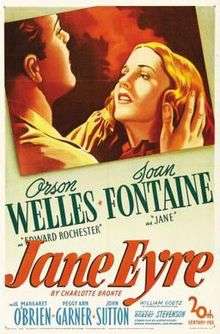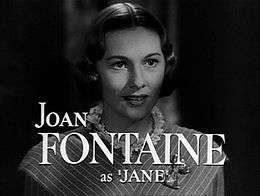Jane Eyre (1943 film)
| Jane Eyre | |
|---|---|
 Theatrical release poster | |
| Directed by | Robert Stevenson |
| Produced by |
William Goetz Kenneth Macgowan Orson Welles (uncredited) |
| Written by |
John Houseman Aldous Huxley Robert Stevenson Henry Koster (uncredited) |
| Based on |
Jane Eyre 1847 novel by Charlotte Brontë |
| Starring |
Orson Welles Joan Fontaine |
| Music by | Bernard Herrmann |
| Cinematography | George Barnes |
| Edited by | Walter Thompson |
| Distributed by | 20th Century Fox |
Release dates |
|
Running time | 97 min |
| Country | United States |
| Language | English |
| Budget | $1,705,000[2] |
| Box office |
$1.75 million (US/Canada) (rentals)[3] 2,620,527 admissions (France, 1946)[4] |
Jane Eyre is an American film adaptation of Charlotte Brontë's 1847 novel of the same name, released by 20th Century Fox. It was directed by Robert Stevenson and produced by William Goetz, Kenneth Macgowan, and Orson Welles (uncredited). The film stars Welles and Joan Fontaine. Elizabeth Taylor made an early, uncredited appearance as Helen Burns.
The screenplay was written by John Houseman, Aldous Huxley, Henry Koster, and Robert Stevenson, based on a radio adaptation of the novel presented on The Mercury Theatre on the Air, on which John Houseman collaborated. The music score was by Bernard Herrmann and the cinematography by George Barnes.
Plot
Orphaned, unloved, and unwanted ten-year-old Jane Eyre (Peggy Ann Garner) lives with her cruel and selfish, uncaring paternal aunt, Mrs. Reed (Agnes Moorehead) of Gateshead Hall. Jane is ecstatic when Mrs. Reed, eager to be rid of the child, arranges for Jane to be sent to Lowood Institution, a charity boarding school for young girls, run by the disciplinarian Reverend Brocklehurst (Henry Daniell).
Based on what Mrs. Reed has told him, Mr. Brocklehurst labels Jane a liar in front of her inmates and orders her to stand on a stool for hours on her first day of attendance. She is comforted and befriended by another student, Helen Burns (Elizabeth Taylor). Later, Jane protests when Brocklehurst orders that Helen's naturally curling hair be cut. Both are punished by being forced to walk circles in a courtyard during a downpour. Dr. Rivers (John Sutton), a sympathetic physician who periodically checks on the students, brings them inside, but it is too late for Helen, who dies that night.
Ten years later, in 1840, 20-year-old Jane (Joan Fontaine) turns down Brocklehurst's offer of a teaching position. She advertises for and accepts a job as governess for a young girl named Adele (Margaret O'Brien). When she arrives at Thornfield, a gloomy, isolated mansion, she initially thinks her employer is Mrs. Fairfax (Edith Barrett), who is only the housekeeper for the absent master.
Jane goes for a walk one night, only to startle a horse into throwing and slightly injuring its rider, Edward Rochester (Orson Welles)—who she doesn't realize is her employer. When Jane arrives back at Thornfield, she discovers this fact, and Rochester calls her into his library to interview her.
That night, Jane is awakened by strange laughter. She investigates, and discovers that Mr. Rochester's bed curtains are on fire. She rouses the sleeping man and they extinguish the fire without rousing anyone. Rochester bids her wait while he goes to another wing of the house, where mysterious seamstress Grace Poole (an uncredited Ethel Griffies) keeps to herself. When he returns, he tells Jane nothing other than that the matter is under control. The next morning, he leaves Thornfield.
A winter and spring go by before he returns with a large group of guests. Jane is greatly saddened when Mrs. Fairfax discloses that everyone expects Rochester to marry Blanche Ingram (Hillary Brooke). However, Rochester confides to Jane his conviction that Miss Ingram is attracted only by his wealth.
When a man named Mason (an uncredited John Abbott) of Spanish Town, Jamaica, arrives at Thornfield, Jane sees that Rochester is disturbed. That night, a scream awakens everyone. Rochester assures his guests it is just a servant's reaction to a nightmare, but after he sends them back to their rooms, he has Jane secretly tend a bleeding Mason, while he fetches a doctor. Jane assumes Grace is responsible. Rochester has the doctor take Mason away.
Rochester has a private conversation with Blanche, in which he bluntly asserts that she is a gold-digger. Offended, she and the guests leave. Unaware of this development, Jane broaches the topic of her future employment elsewhere after Rochester gets married. He reveals to Jane that he intends to marry her.
During the wedding ceremony, an attorney intervenes and announces that Rochester has a wife named Bertha, who is mentally ill and deranged. This is confirmed by Mason, Bertha's elder brother. Rochester calls off the marital ceremony and takes them back to Thornfield to reveal his insane spouse, who lives in a tower cell, guarded by Grace Poole. Jane rejects Rochester's offer to leave England together. She departs Thornfield.
With her funds exhausted, she returns to Gateshead. She discovers that her aunt has suffered a stroke, caused by worry over the ruinous gambling habits of her son, who it is revealed has committed suicide. There is a reconciliation. After Mrs. Reed dies, Jane ponders what to do next, when she hears an anguished and beloved male voice from thin air calling her name.
She travels to Thornfield, which she finds in ruins. Mrs. Fairfax informs her that the lunatic escaped, set the place on fire, and fled to the roof. When Rochester tried to rescue her, she jumped and was killed. He was blinded when the burning stairway collapsed underneath him. With no other impediments, Jane joyfully returns to him. She narrates that, when their son was born, her husband's vision was sufficiently restored for him to see their child.
Cast



- Orson Welles as Edward Rochester
- Joan Fontaine as Jane Eyre
- Margaret O'Brien as Adele Varens
- Peggy Ann Garner as Jane Eyre as a child
- John Sutton as Dr. Rivers
- Sara Allgood as Bessie, Mrs. Reed's servant, whom Jane is saddened to leave
- Henry Daniell as Henry Brocklehurst
- Agnes Moorehead as Mrs. Reed
- Aubrey Mather as Colonel Dent
- Edith Barrett as Mrs. Alice Fairfax
- Barbara Everest as Lady Ingram
- Hillary Brooke as Blanche Ingram
- Elizabeth Taylor as Helen Burns (uncredited)
- Barry Macollum as a trustee (uncredited)
Production
The movie was developed by David O. Selznick who sold it as a package to William Goetz at 20th Century Fox, which Goetz was running in the absence of Darryl F. Zanuck.[2]
Jane Eyre premiered in New York February 4, 1944.[5] According to TCM, although the film had its British premiere in late December 1943, "it was a 1944 U.S. release and bears a 1944 copyright in its on-screen credits, so it's officially considered a 1944 picture."[6]
The film was acclaimed for its recreation of the Yorkshire Moors. It was actually filmed entirely in Hollywood on a heavily disguised sound stage. The long shadows and heavy fog, which added the air of a Gothic novel lacking in so many remakes, were rumored to have been the brainchild of Orson Welles. He was offered a producer's credit as thanks for his contribution but declined the offer, believing that a person who is not a director shouldn't be "just" a producer.
Bernard Herrmann was the second choice for the composer. Igor Stravinsky was originally approached by Welles, and he even got so far as writing music for a hunting scene, which he later used in his Ode for orchestra, premiered in 1943.[7]
The score for Jane Eyre is based on the score Herrmann wrote for the December 9, 1938, broadcast of Rebecca, the first episode of Orson Welles's radio series, The Campbell Playhouse.[8]:67 During his scoring of the film, Herrmann started working on his opera Wuthering Heights, based on the novel of the same name by Charlotte Brontë's sister Emily. He quoted some themes from the Jane Eyre score (and others of his earlier scores) in the opera.
Home media
- 1993: Fox Video, VHS (1247), ISBN 978-0-7939-1247-6, 1993
- 2007: 20th Century Fox Home Entertainment, Region 1 DVD, UPC 024543425748, 2007.
Special features theatrical trailer and production stills; audio commentary by Joseph McBride and Margaret O'Brien; audio commentary by Nick Redman, Steven C. Smith and Julie Kirgo; isolated music track; "Know Your Ally Britain", directed by Robert Stevenson; "Locked in the Tower: The Men Behind Jane Eyre" (2006), written and directed by John Cork, with commentary by Scott McIsaac, Simon Callow, Bob Thomas, Hugh Stevenson, Venetia Stevenson and Ursula Henderson. - 2013: Twilight Time, Screen Archives Entertainment, Blu-ray Disc (limited edition of 3,000), November 12, 2013. Includes special features in 2007 DVD release. Critic Glenn Erickson wrote, "Bernard Herrmann fans will be interested in the film's isolated 'M&E' (music and sound effects) track, which makes this disc a dynamite soundtrack experience as well."[9]
References
- ↑ Welles, Orson, and Peter Bogdanovich, edited by Jonathan Rosenbaum, This is Orson Welles. New York: HarperCollins Publishers 1992 ISBN 0-06-016616-9.
- 1 2 Memo from Darryl F. Zanuck, Grove Press 1993 p 64-65
- ↑ Solomon, Aubrey (1989). Twentieth Century Fox: A Corporate and Financial History. Lanham, Maryland: Scarecrow Press, p. 220, ISBN 978-0-8108-4244-1.
- ↑ French box office of 1946 at Box Office Story
- ↑ "Jane Eyre". AFI Catalog of Feature Films. November 4, 1986. Retrieved 2014-01-09.
- ↑ "Jane Eyre". Turner Classic Movies.
- ↑ Jacobson, Bernard. "Ode for Orchestra". Retrieved 1 October 2013.
- ↑ Smith, Steven C., A Heart at Fire's Center: The Life and Music of Bernard Herrmann. Berkeley: University of California Press, 1991 ISBN 0-520-07123-9
- ↑ "DVD Savant Blu-ray Review: Jane Eyre". Glenn Erickson, DVD Talk, November 20, 2013. Retrieved 2014-01-22.
External links
| Wikimedia Commons has media related to Jane Eyre (1943 film). |
- Jane Eyre at the American Film Institute Catalog
- Jane Eyre at the Internet Movie Database
- Jane Eyre at the TCM Movie Database
- Jane Eyre at AllMovie
- Jane Eyre at Rotten Tomatoes
- Review at JaneEyre.net
- 1944 Jane Eyre Trailer, Orson Welles, Joan Fontaine
Streaming audio
- Jane Eyre on The Campbell Playhouse, March 31, 1940 (Orson Welles and Madeleine Carroll)
- Jane Eyre on The Philco Radio Hall of Fame, February 13, 1944 (Joan Fontaine, 20:40–32:20)
| ||||||||||||||||||||||||||||||
| ||||||||||||||||||||||||||||||||||||||||||
|